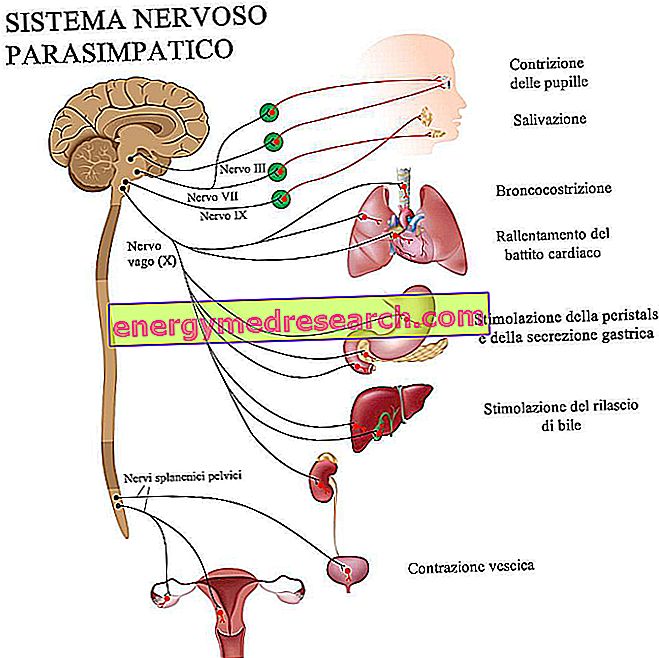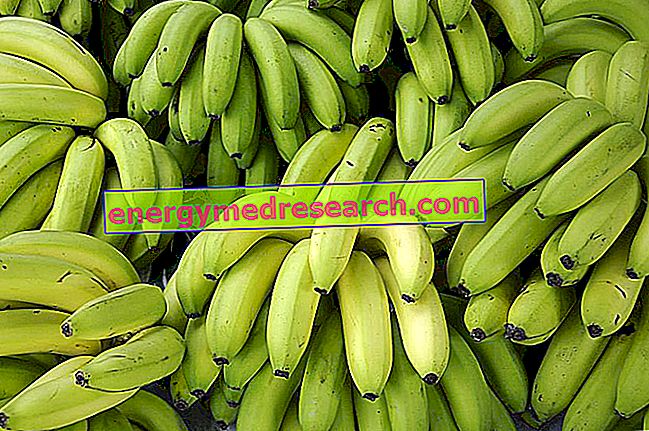Watch the video
X Watch the video on youtubePremise
For a long time, the banana has gained a prestigious role in the tables of the global population: not surprisingly, the banana seems to be the most consumed fruit in the world, thanks to its beneficial properties and its characteristic flavor.
Nutritional composition
As already mentioned in the "banana" article, the fruit consists of water (75%), carbohydrates (23%), fiber (2.6%), proteins (1%) and fats (0.3%): these nutritional values may present some variations depending on the different categories, the different stage of maturation, as well as the techniques and places of cultivation.

Vitamin B6, despite being present only in minimal quantities, facilitates protein metabolism.
Among the trace elements, potassium is certainly the most important mineral, followed by calcium, phosphorus, copper and iron: for this reason the banana is given remineralizing properties. The iron contained in the banana is useful in case of anemia (anti-anemic properties: it promotes the regeneration of red blood cells).
Potassium seems to play a fundamental role in facilitating the proper functioning of the cardiovascular system: for those suffering from mild and uncomplicated hypertension it is recommended to consume bananas for this reason (known hypotensive properties).
The banana contains many simple sugars and carbohydrates: in this regard, the consumption of the banana must be reduced within a low-calorie diet. Bananas are made from sucrose, glucose and fructose, three simple sugars used by the body as energy (energy property).
To learn more: banana nutritional values
Banana and Chocolate Cold Cake - Cheesecake
X Problems with video playback? Reload from YouTube Go to Video Page Go to Video Recipes Section Watch the video on youtubeBanana properties
When eaten fresh, the banana can lighten the problems related to gastric ulcer: in fact the fruit could neutralize the acidity created by the gastric juices, stimulating the production of mucus: by doing so, the healing of wounds created by the ulcer is facilitated.
Thanks to its energetic and nourishing properties, banana consumption is recommended for athletes, due to the presence of dopamine, noradrenaline, thiamine and serotonin, vasoactive substances.
Due to the presence of some proteins enclosed in the pulp (protein Ba1, Ba2 and Mus XP 1), the banana could trigger allergic manifestations in particularly sensitive subjects.
The peel of the banana, often, is characterized by small dark patches: it is a normal process of maturation due to the production of serotonin by the tryptophan present in the peel of the fruit. Hence the assumptions according to which the banana can boast mild natural antidepressant properties: in reality it cannot properly be considered as such, since at the gastric level serotonin is digested by enzymes.
Bananas, when smoked, are also attributed potentially hallucinogenic properties: considering, however, that the melting point of serotonin is very high, toxic oxides of nitrogen and carbon are produced during combustion. However, serotonin cannot pass the blood-brain barrier, so it is not perceived in the brain.
Banana juice and properties
The fruit, when consumed fresh, can be exploited for the production of jams; even juices can be made from fresh banana. Despite being made up of a large quantity of water, the banana has found many difficulties to be transformed into juice: in fact, when pressed, only a flattened pulp is formed. In India, to remedy this problem, two scientists from the Bhabha Atomic Research Center have studied a way to produce the juice, placing the reduced pulp banana in a container specifically designed to create a reaction from which the juice will be obtained.
Another way to consume the fruit is drying.
"Purifying" properties
Particular and curious was the study followed by a research doctor at the Federal University of Sao Carlos (Brazil): the banana peels could be helpful in the water purification process, being useful in extracting metal pollutants such as lead and copper. In this process, first and foremost the banana peels must be dried, then these are pulverized and then sieved to obtain particles of the same diameter. Since the particles are negatively charged, they would be able to attract metals (with negative charge): the result was surprising, since the pollution of the water has been greatly reduced.
Curiosity
In ancient times, anti-psoriasis and non-inflammatory / non-contagious chronic dermatitis (responsible for skin lesions and erythematous plaques) were attributed to the banana.
Again, the peel could even act as shoe polish.
The Canadian ivy produces an annoying irritation: in ancient times, the inner part of the banana peel was considered a good natural remedy to avoid the annoyance caused.
The depiction of a person who, walking, slips on a banana peel has been the subject of theatrical comedies since ancient times, and still is.
In Chinese culture, associating a person with a banana is a sign of contempt: the metaphor - which indicates "yellow outside and white inside" - is usually attributed to those who have Chinese origins but do not know or appreciate their tradition.
Summary
Banana properties: in short
Banana: nutritional composition | Water 75% Carbohydrates 23% → energy properties 2.6% fiber 1% protein Fat 0.3% |
Vitamins | Vitamin A B vitamins (B1, B2 and PP) C vitamin Traces of vitamin E Vitamin B6à facilitates protein metabolism |
Minerals | Potassium hypotensive properties Calcium, phosphorus, copper → mineralizing properties Iron → antianemic properties |
Vasoactive substances | Dopamine, noradrenaline, thiamine and serotonin → energetic and nutritional properties: indicated for athletes |
Advantageous properties of the banana |
|
Disadvantageous properties of the banana | Potentially allegorizing properties of Ba1, Ba2 and Mus XP protein 1 Potentially hallucinogenic properties of the smoked banana peel during combustion produce toxic nitrogen and carbon oxides |
| Mode of consumption of the fruit | Fresh fruit Banana jams Banana juice Dried banana |
| Banana purifying properties | Banana peel: useful in water purification (extraction of metal pollutants) |
| Ancient banana properties |
|



